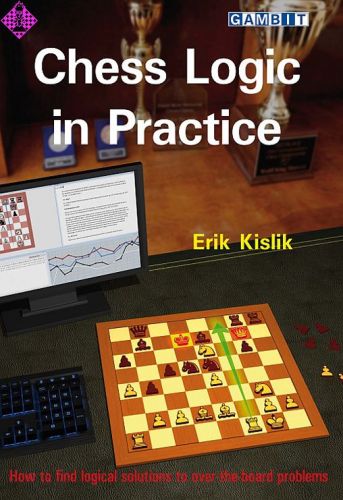Artikelnummer
LXKISCLIP
Autor
Chess Logic in Practice
240 Seiten, kartoniert, Gambit, 1. Auflage 2019
Vorübergehend ausverkauft
Chess-players understand that it is vital to play logically, but often lack the methods needed to do so. In this book, renowned trainer Erik Kislik presents a wide range of specific concepts that will help them succeed. These include positional techniques, thinking methods, and modes of play to adopt when either better or worse.
Just the list of chapter titles shows how original Kislik’s presentation is. They include:
Erik Kislik is an International Master originally from California who lives in Budapest. He is an expert in computer chess and one of the most in-demand chess trainers on ICC. He has coached many grandmasters and assisted a number of elite players with their opening preparation. His previous book for Gambit, Applying Logic in Chess, has been widely praised.
Just the list of chapter titles shows how original Kislik’s presentation is. They include:
·Painfully Slow Moves
·Focal Points
·Reciprocal Logic
·Fighting against Centralized Pieces
·When Playing a Bad Move Wins a Good Game
·A Chronically Weak King
Throughout, the discussion is illustrated by a mass of examples from both recent elite chess and the play of Kislik and his students, showing how his themes cut across all levels of chess. After the book’s two main sections Thinking Concepts and Positional Concepts comes a section of exercises, again with a strikingly original theme: our task is simply to assess each position.Erik Kislik is an International Master originally from California who lives in Budapest. He is an expert in computer chess and one of the most in-demand chess trainers on ICC. He has coached many grandmasters and assisted a number of elite players with their opening preparation. His previous book for Gambit, Applying Logic in Chess, has been widely praised.
| EAN | 9781911465300 |
|---|---|
| Gewicht | 440 g |
| Hersteller | Gambit |
| Breite | 17,2 cm |
| Höhe | 24,8 cm |
| Medium | Buch |
| Erscheinungsjahr | 2019 |
| Autor | Erik Kislik |
| Sprache | Englisch |
| Auflage | 1 |
| ISBN-13 | 978-1-911465-30-0 |
| Seiten | 240 |
| Einband | kartoniert |
| Name | Gambit Publications Ltd. |
|---|---|
| Adresse | 27 Queens Pine, Bracknell Berkshire RG12 OTL Großbritannien |
| Internet | www.gambitbooks.com |
| info@gambitbooks.com |
Verantwortlicher Importeuer:
| Name | Schachversand Niggemann |
|---|---|
| Adresse | Schadowstraße 5 48163 Münster Deutschland |
| info@schachversand.de | |
| Internet | www.schachversand.de |
004 Symbols
004 Material Values
005 Foreword by GM Hjörvar Steinn Gretarsson
006 Introduction
007 Part 1: Thinking Concepts
007 1) Progressive Thinking
016 2) Reciprocal Logic
024 3) The Method of Elimination
030 4) Tenacity
039 5) Optical Biases
048 6) Only One Way to Lose
053 7) Only Idea to Play For
059 8) Simplification as a Tool for Equalization
064 9) Overpressing
075 10) When Playing a Bad Move Wins a Good Game
083 11) When You Have to Go for It
089 12) Taking Risks in Bad Positions
092 Part 2: Positional Concepts
092 1) Playing without Weaknesses
105 2) Fighting against Centralized Pieces
121 3) Incorrect Piece Exchanges
131 4) Focal Points
142 5) Provoking Pawn-Weaknesses
150 6) Sliding Moves
155 7) Flank Thrusts
163 8) A Chronically Weak King
175 9) Playing with a Bad Queen
182 10) The Defensive Power of the Queen
184 11) Unlikely Draws
195 12) Painfully Slow Moves
202 13) Manoeuvring in Closed Positions
213 14) Neutral Bad Bishops
216 Part 3: Exercises
216 Exercises
222 Solutions
236 Index of Players
239 Index of Openings
004 Material Values
005 Foreword by GM Hjörvar Steinn Gretarsson
006 Introduction
007 Part 1: Thinking Concepts
007 1) Progressive Thinking
016 2) Reciprocal Logic
024 3) The Method of Elimination
030 4) Tenacity
039 5) Optical Biases
048 6) Only One Way to Lose
053 7) Only Idea to Play For
059 8) Simplification as a Tool for Equalization
064 9) Overpressing
075 10) When Playing a Bad Move Wins a Good Game
083 11) When You Have to Go for It
089 12) Taking Risks in Bad Positions
092 Part 2: Positional Concepts
092 1) Playing without Weaknesses
105 2) Fighting against Centralized Pieces
121 3) Incorrect Piece Exchanges
131 4) Focal Points
142 5) Provoking Pawn-Weaknesses
150 6) Sliding Moves
155 7) Flank Thrusts
163 8) A Chronically Weak King
175 9) Playing with a Bad Queen
182 10) The Defensive Power of the Queen
184 11) Unlikely Draws
195 12) Painfully Slow Moves
202 13) Manoeuvring in Closed Positions
213 14) Neutral Bad Bishops
216 Part 3: Exercises
216 Exercises
222 Solutions
236 Index of Players
239 Index of Openings
Mehr von Gambit
-
 Lektionen zur Schachstrategie19,95 €
Lektionen zur Schachstrategie19,95 € -
 Schacheröffnungen für Kids17,95 €
Schacheröffnungen für Kids17,95 € -
 A Complete Chess Course16,95 €
A Complete Chess Course16,95 € -
 Die Damenindische Verteidigung15,95 €
Die Damenindische Verteidigung15,95 € -
 Chess Opening Workbook for Kids15,50 €
Chess Opening Workbook for Kids15,50 € - Mehr von Gambit



